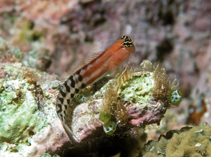| Family: |
Blenniidae (Combtooth blennies), subfamily: Salariinae |
| Max. size: |
3.9 cm SL (male/unsexed) |
| Environment: |
reef-associated; marine; depth range 0 - 24 m |
| Distribution: |
Western Central Pacific: endemic to Fiji Islands. |
| Diagnosis: |
Dorsal spines (total): 12-12; Dorsal soft rays (total): 13-14; Anal spines: 2-2; Anal soft rays: 15-16; Vertebrae: 31-33. Dorsal fin XII, 13 or 14, deeply notched between spinous and segmented-ray portions. Anal fin II,15 or 16. Pectoral fin 13 or 14 (rarely 14). Caudal fin 13. Vertebrae 10 + 21-23 (usually 22). Dentary incisor teeth 36-50 which includes anterior canine teeth very similar in appearance
with incisors; posterior canines usually 1 on each side. Lateral line lacking vertical pairs of pores, terminating posteriorly at point between verticals from dorsal-fin spines 10 and 12
(typically at 12). With cirrus on posterior rim of anterior nostril; absent on anterior rim. |
| Biology: |
Oviparous. Eggs are demersal and adhesive (Ref. 205), and are attached to the substrate via a filamentous, adhesive pad or pedestal (Ref. 94114). Larvae are planktonic, often found in shallow, coastal waters (Ref. 94114). |
| IUCN Red List Status: |
Least Concern (LC); Date assessed: 25 March 2009 Ref. (130435)
|
| Threat to humans: |
harmless |
| Country info: |
|
Source and more info: www.fishbase.org. For personal, classroom, and other internal use only. Not for publication.

